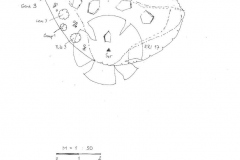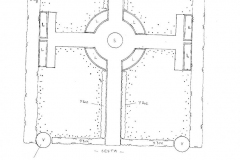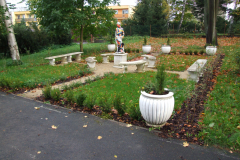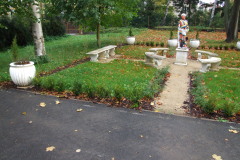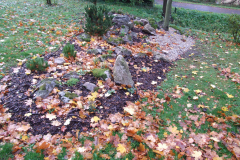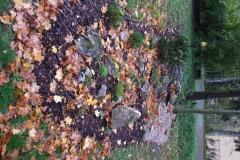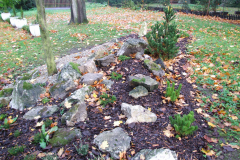
An alpinum (or alpinarium, alpine garden) is a botanical garden specialized in the collection and cultivation of alpine plants growing naturally at high altitudes around the world, such as in the Caucasus, Pyrenees, Rocky Mountains, Alps, and Himalayas.
An alpinum tries to imitate the conditions of the plants‘ place of origin, for example, large stones and gravel beds. One of the main obstacles in developing an alpinum is the, for the plants, non-natural conditions which exist in some areas, particularly mild or severe winters and large rainfall (e.g. United Kingdom and Ireland). This is avoided by growing the plants in alpine greenhouses, which tries to reproduce the ideal conditions. The first true alpinum was created by Anton Kerner von Marilaun in 1875 on the mountain Blaser, in Tyrol, Austria, at an altitude of 2190 meters above mean sea level. Typical plants found in an alpinum include:
- Androsace
- Campanula (alpine species)
- Dianthus (alpine species)
- Gentiana
- Globularia
- Leontopodium
- Pulsatilla
- Primula (alpine species)
- Ranunculus
- Saxifraga
For the construction of Alpine Gardens are necessary not only plants, rock garden plants, butalso other materials such as stones to be different sizes and shapes at a suitable height gradation. Alpine garden is representative of a suitable combination of biotic and abiotic forms of nature.
• Biotic part is richer in its tender. From the trees are a good complement to dwarf forms of pine, less pendulous spruce , juniper, creeping juniper, heather, blueberries, cranberries, grasses and other similar catch-soil materials. The choice and combination of plants should be spread so as to preserve the rule of constant continuous flowering alpine garden at any time of the growing season.
• Abiotic part is represented by the scree field and stone groups.
• The transition between the two forms is an area which focuses on pieces of old wood,dying symbol of living matter, which is subject to change through the process of decomposition and small animals.
Mineralogy
is a discipline dealing with the study of minerals (or minerals), their internal structure, appearance, physical and chemical properties, their formation, occurrence and transformations in nature. An important aspect is the application of acquired knowledge, ie the possibility of industrial and technical applications in practice.Mineralogy is part of the geological sciences.
Source: Mineralogie. In Wikipedia : the free encyclopedia [online]. St. Petersburg (Florida) : Wikipedia Foundation, [cit. 2011-10-22]. Dostupné z WWW: <http://cs.wikipedia.org/wiki/Mineralogie>.
Source: VÁVRA, Václav ; LOSOS, Zdeněk . Multimediální studijní texty z mineralogie pro bakalářské studium [online]. Brno : Ústav geologických věd, Přírodovědecká fakulta Masarykovy univerzity v Brně, 2006, 21. 10. 2011 [cit. 2011-10-22]. Dostupné z WWW: <http://www.sci.muni.cz/mineralogie/index.htm>.
Minerals, or homogeneous minerals, are inorganic products of nature. Their composition may be expressed through their chemical symbol or chemical formula.
At present, we know roughly four thousand minerals. However, only about three hundred of them commonly occur in nature. Note: We consider some natural organic substances as minerals (eg amber).

Amber (fossilized organic resin of ancient trees, originating from tens of millions of years ago, its average chemical composition is C10H16O)
Source: http://www.sodalit.estranky.cz/fotoalbum/krystaly/krystaly/jantar.-.html
Minerals are basic building blocks of rocks, which form an integral part of our environment.
Rock is an (inevitably recurring) mixture of minerals, or residues of organic origin. But it can also be formed by a single mineral; limestone is such example. The rocks are extensively involved in the construction of the earth’s crust. Examples of rocks: granite, basalt, slate, etc.

Gray crystalline limestone
(Vitošov quarry, Jeseník)
Source:
http://www.geology.cz/app/museum/m.pl?g=2298&det=A&pitem=402
Studying rocks is the main task of petrology. It examines their mineral and chemical composition, structure, conditions of Petrology, etc., with all its sub-disciplines, this branch of science allows us to understand the evolution of the earth’s crust and mantle, Earth, and other planetary bodies. 99% of all rocks are made up of approximately only 30 minerals. These minerals are called rock-forming. They include for instance quartz, feldspar, or mica.
Rocks are divided into three major groups according to their origin:
• igneous rocks (igneous, eruptive)
• sedimentary rocks (established) and
• metamorphic rocks (metamorphosed).
As the name implies – the igneous are formed through crystallization of magma, the metamorphic are a result of the conversion of other ones, and sedimentary rocks are formed through settling of weathered particles in different environments.

Granite is a rock consisting of minerals quartz, feldspar (orthoclase and plagioclase) and mica (biotite).
The rock cycle
Certain processes give rise to various kinds of rocks, while other processes in turn cause their demise and the emergence of other rocks. Each of the three types of rocks as outlined above can be changed by different processes into different rock of any type. We can give some examples: Any rock (igneous, sedimentary and metamorphosed) can slake, and its particles are tolerated in places where there is the establishment and formation of sedimentary rock, or it can get into great depths, where it will melt in the magma, of which may later be a new igneous rock, or any rock can be exposed to pressure and temperature, creating a new metamorphic rock. There is a constant movement within the earth’s crust and the upper part of the mantle.
Source: Matejka, Dobroslav, et al. Mineralogy for schools [online]. Institute of Geochemistry, Mineralogy and Mineral Resources, Faculty of Science, Charles University in Prague, 2005 [cit. 10.22.2011]. What is a mineral. Available from WWW: <http://web.natur.cuni.cz/ugmnz/mineral/index.html>.
TEST in Petrology
The main rock-forming minerals of the earth’s crust belong to a group of minerals called (1). The predominant minerals in rocks are called (2) minerals, those that always occur in subquantities are called (3) minerals. Rocks are divided into three main groups according to their origin (4), (5) and (6). The correlation of rock components is (7). Spatial arrangement, noticeable mostly macroscopically, is (8). Igneous rocks stiffened by earth’s surface are referred to as (9). The light minerals of igneous rocks are mainly (10) and quartz. Among the most important rock-forming minerals are dark (11), (12) and (13), except those, olivine is significant in some as well. If the rock contains 44-53% of SiO2 by chemical analysis, it is a (14) rock. A typical underground rock with a predominance of alkali feldspar and quartz is (15), (16) occurs on the surface of the same rock called magma. Sequence of minerals excretion from the magma is expressed through (17). In it, the last member is a mineral called (18). If the silica contents in the magma is low, instead of the alkali feldspar elements minerals are formed known as (19); they include for instance analcim, leucite and nephelinite. They are often volcanic, in the Czech Central Mountains there is one such type whose Czech name (20) is derived from the sound of the rock by shock. Igneous rock with a predominance of dark minerals and olivine is specifically called (21). Gabbro is underground rock. Once stiffened, the magma at the surface is of the same composition (22). If the crystal in the rock minerals is much larger than the other minerals, it is named as (23). Effused syenite is equivalent to (24), while the underground equivalent of andesite is (25).
Source: University of West Bohemia in Pilsen
Faculty of Education Department of Biology [online]. 2009
[cit. 10.22.2011].
Petrography. Available from WWW: <http://www.kbi.zcu.cz/studium/geo/pet.htm.

